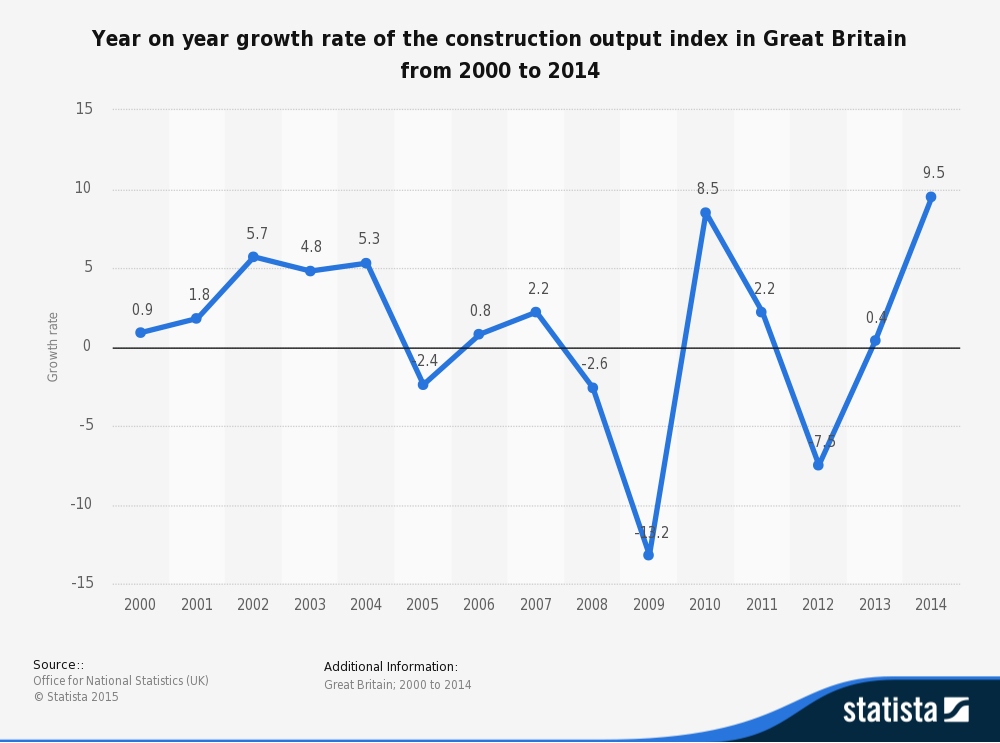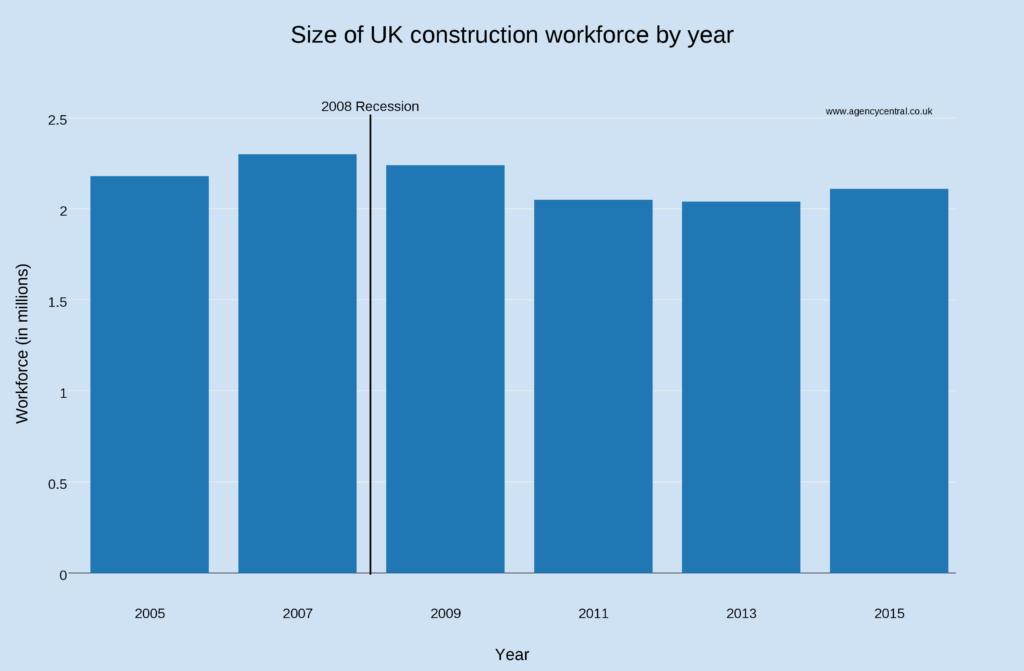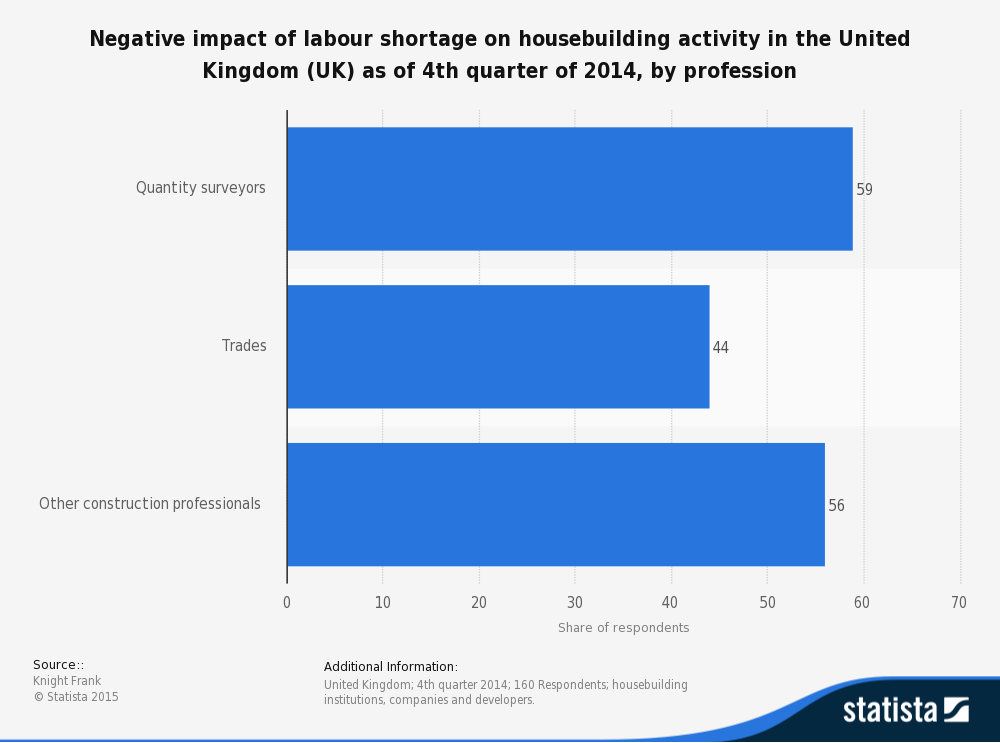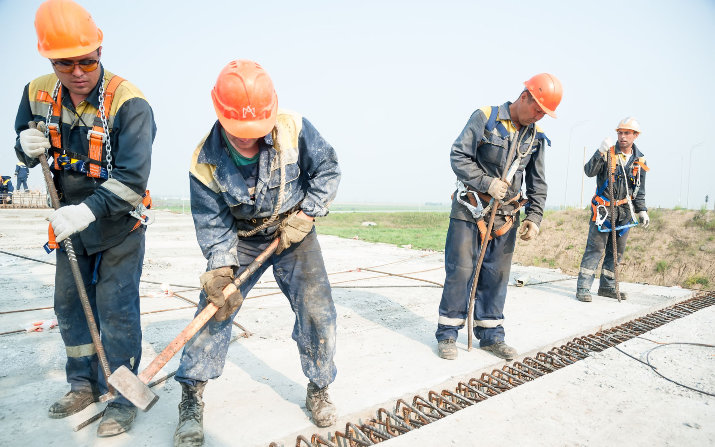The UK construction sector is one of the country’s leading economic drivers, however a perceived shortage of skilled professionals is becoming a challenge for a field that relies on its workforce more than most.
Employers and specialist construction recruitment agencies are experiencing first hand the lack of qualified candidates – the Trade recruitment market is always crying out for qualified workers. Though the industry remains a vital area for employment, the economy and social growth, skill gaps are threatening to derail a market in recovery.
Construction industry overview
The construction industry is one of the supporting pillars of the UK economy. While initial thoughts may throw up images of hard hats and builder’s behinds, the industry is far-reaching and covers areas such as architecture, civil engineering and even Laurence Llewelyn Bowen.
Due to the high cost/high risk nature of construction, the industry is generally a good barometer of how the wider economy is performing. A struggling economy sees a slowdown in new projects, while a UK in recovery will result in a deluge of investment.
Currently investment is growing. New housing initiatives have resulted in a strong performing sector and the longest period of growth since the last recession. Confidence is improving amongst employers, meaning it’s a great time for those that want to work in construction, however a shortage of skills acts as a potential risk to continued expansion.
What is the construction industry worth to the UK economy?
In 2014, the construction industry generated £103 billion, a figure that equates to nearly 6.5% of the UK’s total output. As the graph below shows, the industry is currently experiencing record output growth following the crashes of 2009 and 2012.

Despite these numerous economic fluctuations, construction has always been a stable source of revenue and falls behind only manufacturing and the service sectors as the country’s leading contributor of GVA (gross value added).
How many people work in construction?
2.1 million people work within the industry, and despite occasional drops caused by recessions, employment figures have remained fairly constant over the last decade. As a proportion of the UK labour market as a whole, the percentage construction jobs has varied slightly since 2005, falling by nearly 1%.
Is there a skills shortage?
Although the construction industry looks to be on solid ground, the foundations are slowly eroding away and employers fear that there aren’t enough bricklayers, plumbers and project managers coming through to repair them.
In a report by the Recruitment and Employment Confederation (REC), the skill shortage in construction and engineering was described as ‘critical’. Although the number of job opportunities are rising, the number of suitable candidates isn’t and the Construction Industry Training Board (CITB) estimates that more than 36,000 new workers a year will be needed to cover current demand. This is easier said than done though, as more than half of employers are finding it difficult to fill skilled vacancies.
While any shortage is dictated by current market conditions, the Royal Institute of Chartered Surveyors (RICS) has predicted that this lack of skills could impact 27,000 construction projects each year until 2019. The RICS survey also showed that 66% of surveying firms have already been forced to turn down work due to a lack of staff and this could be set to grow over the next five years.
What has caused the skills shortage?
With the skills shortage being experienced by employers across the UK, just what is it that has led to this dwindling workforce? A combination of factors can be credited with forcing open the construction skills gap, but put simply, there aren’t enough staff to cover the demand. This is largely due to a diminishing uptake of the profession, ageing staff and a boom in investment.
The number of apprentices entering the sector
The state of a recession hit industry has greatly impacted the number of new workers entering the profession and this is illustrated by the Department of Business Innovation and Skills. In the year 2013-2014, there were 8,000 apprentices within ‘Construction, Planning and the Building Environment,’ a figure that’s continually dropped for the last five years. In 2008-2009, the number of completed apprenticeships exceed this by more than 10,000, showing a 55% decrease since pre-recession statistics.
“A combination of factors can be credited with forcing open the construction skills gap, but put simply, there aren’t enough staff to cover the demand.”
There is some good news however, and the number of candidates starting apprenticeships has started to grow. Although figures in recent years have typically fallen a little under 14,000, the last year has seen this rise by over 14%. This however, is still someway short of the 36,000 that is currently needed.
Ageing workforce
The UK is currently experiencing an ageing population and the construction sector is set to see more skills leave the industry than any other area of work. The baby boomer generation is slowly reaching the career finish line and employers are understandably concerned that younger workers aren’t coming through to replace them.
Around a quarter of the construction workforce is now over the age of 50, while 400,000 of the over 55s are planning to retire in the next decade. Furthermore, the increase in the number of workers over the age of 60 is the largest of any age group in the sector, with the biggest drop off being in the under 30 bracket. While experience is invaluable in any working environment, current trends suggest that the workforce will begin to decline as new workers are unable to meet the demand left behind by retiring practitioners.
Rising investment
As investment in construction projects starts to grow, the demand for staff is only further highlighting the lack of skilled professionals currently in the market. In August, the Government Construction Pipeline showed that around £119 billion worth of projects were planned for the next five years. This is spread across 2,206 programmes within sectors such as transport, energy and education.
Irrespective of government spending, Q3 of 2015 saw output in construction fall for the first time in two years. Despite forecasts to the contrary, output in August fell by 4.3%, with housebuilding experiencing a 3% decline month on month. Although this was reversed in September, this was considered a sign that supply of staff couldn’t match the rise in investment.
In order to keep up with housing plans, it’s predicted that 1 million construction workers are needed by 2020. The government hopes to build 275,000 affordable homes in this time, however the Local Government Authority warns that a skills shortage could impede any progress. This has made construction staff the most in demand within recruitment circles according to the REC and KPMG.
How recessions affect the skill shortage
With every recession comes the inevitable layoffs and the construction industry is certainly not immune to this. While skills may be leaving the industry for the short-term, it can also have longer term implications as workers may no longer be there when the market improves.

Over the last decade, the construction workforce has fluctuated, but peaked in 2007 at 2.3 million people. Since the 2008 recession however, numbers have fallen considerably and nearly 400,000 jobs were lost following the late noughties market crash. In fact, construction was one of the worst hit areas for employment, leading to a vast number of skills leaving the UK to fill roles overseas.
Recruitment agencies have witnessed first hand the impact that the recession has had on employer behaviour. Rebecca Hilling, Operations Manager for Berry Recruitment in Falmouth, said: “The Construction Temp market did remain strong for us with more companies preferring to use agencies during the recession. This is because they were not in a position to commit to taking on permanent staff, due to uncertainty in the market place.”
Although job prospects now appear to be on the up (largely helped by housebuilding), it’s not guaranteed that those who have left the industry will be there to jump straight back in. Some professionals may have retired, others may have retrained in another vocation. Job decline will also have hurt those trying to break into the industry, with employers lacking the confidence to make allowances for apprentices or graduates.
North-South divide?
The North-South divide impacts both culturally and economically, with London typically being the epicentre of the construction job market. The construction job market north of Milton Keynes has always been in the shadows of its South East counterpart, however it’s now the widening skills gap that’s causing concern to an otherwise recovering industry.
The Northern Powerhouse
The Northern Powerhouse is a growing region for output, however a lack of staff is undermining what could be a strong Tyneside market. The North East has the potential to lead the charge outside of London and more than 17,500 jobs are expected to be created over the next few years. The region is predicted to experience construction growth of 2.3%, which has been helped greatly by new projects in Newcastle and Northumberland. Additionally, infrastructure is set to grow by 5.8% during the next five years, which is more than twice that of the UK average (2.4%).
Unfortunately, the North East is experiencing its worst shortage of skills in nearly two decades and this could hamper any possible growth. The RICS reported that 93% of firms in the region have turned down work due to a skills shortage, and this trend is mirrored across many sub sectors of construction.
Firms lying north of Milton Keynes have always struggled in comparison to their South East counterparts, however it’s now the widening skills gap that’s causing concern to an otherwise growing industry.
Construction in London
London is still the UK construction leader however, with more than £95billion of projects planned between now and 2017. It’s therefore unsurprising to find that the capital is home to the highest number of blue collar workers. Over 300,000 construction staff work in London and this makes up around 15% of the industry. As a percentage of all sectors though, only 5.3% of the London labour market is made up of construction workers (1% behind the national average).
It is thought however, that 65% of workers stay within the same region that they started in. This suggests that the skills crisis is a national problem, as opposed to being localised.
Where are the skill gaps?
Although skill shortages are prevalent across the sector, blue collar workers appear to be the hardest to find. According to the Federation of Builders State of Trade Survey, bricklayers are the most difficult tradespeople to source, closely followed by carpenters and joiners. As with anything, this results in a scarcity value, increasing the salaries that these candidates can command.
Recruiting quantity surveyors is proving just as difficult and the Statista graph below suggests that they may be the biggest barrier to construction activity.

The survey conducted by Knight Frank, shows that 59% of developers and housebuilders believe that a shortage of quantity surveyors has a negative impact on UK projects. At the beginning of the year, the RICS described the surveyor shortage as critical and that this is expected to worsen over the next few years. Training apprentices and new surveyors is always at the whim of a prospering economy, and as such, is the first area to get cut when budgets become tight.
There is a shortage of skills across the board right now though and Rebecca from Berry Recruitment admits that one of the biggest challenges facing recruiters is “trying to find skilled Labour with relevant CSCS/CPCS tickets of a high standard.”
Possible solutions?
Ensuring that the construction sector remains stable will require more than just a roll of sticky tape. In order for the industry outlook to improve, employers will have to find the right balance between attracting new recruits and looking after current workers.
Attract new talent
Arguably the biggest problem for the industry is the lack of young candidates entering the field. Although the number of people starting apprenticeships is beginning to rise, the current rate of uptake still falls short of the necessary numbers to carry out government plans.
Investment is key here but employers might have to take it upon themselves to bring through talent in the absence of larger intervention. The government has opened up opportunities for increased output, but organisations may need to do more in order to bring through and train new staff. Business owners have been encouraged to take the lead in addressing the current skill gap, with the UK Commission of Employment and Skills suggesting a need for ‘greater collaboration between businesses, unions and the workforce’.
According to the CITB, 57% of construction employers in 2014 provided training for staff, a figure below the 66% target set out by the Employer Skills Survey. Additionally, the report also showed that only one in seven employers were employing an apprentice. This may be down to the cost of training a construction newcomer, which is estimated to be around £22,000.
With more than 650,000 young people (16-24) unemployed, employers and skill providers may have to work harder to attract millennials to the industry. The government has set a target of 3 million new apprenticeships across all sectors, and micro firms in construction have a key role to play in helping reach that goal.
Look after the current workforce
With a lack of numbers entering the industry, the ageing workforce is only further highlighted as an impending problem. The demands of the labour involved can take its toll on experienced professionals and this may force them to consider early retirement. Therefore, it stands to wager that by somehow extending the worklife of senior professionals, skills will stay in the industry for longer and these in turn can be passed on to emerging talent.
Retraining imminent retirees could help employers move senior staff into new, less labour intensive roles. A lack of physical fitness is one of the main detriments to having ‘older’ workers and a lawful reason for terminating employment (if the type of work dictates). A management or training job could allow workers to prolong their career while passing on valuable expertise.
Flexible working could also be attractive for staff who may need a little incentive to stay in work longer. The ageing workforce is a problem affecting all industries and 27% of employers across the UK have introduced flexible working plans to entice wantaway employees. The construction industry isn’t perhaps most renowned for it’s capability for flexibility but it would enable workers to manage their time around health and motivation. Of course, this isn’t possible for many smaller firms that are already stretched trying and meet demand.
So what have we learned?
There is currently an imbalance in the construction industry. While output is undoubtedly on the up, the lack of qualified workers is hampering any continued growth. Of course, as the public and private spending on construction increases, resources become stretched and the holes in the labour market become further accentuated. In the absence of any simple solution, it might be time to readdress the see-saw and start to invest in skills as opposed to production. The diminishing workforce is a very real worry for employers and failure to bring through new entrants could prove detrimental to the long term prospects of the industry.
We would like to thank Rebecca Hilling, Operations Manager at Berry Recruitment, Falmouth, for contributing her thoughts towards this article.



